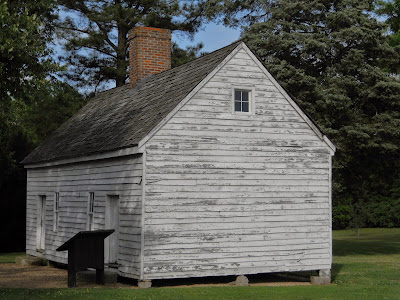Pamplin Historical Park owns several impressive historic structures. On the park's main campus is the Bouisseau family dwelling, which was known as "Tudor Hall." It was used by South Carolinian Gen. Samuel McGowan and his staff as their headquarters from October 1864 to the end of March 1865. Another impressive home is the Hart House, which is just across a branch of Arthur's Swamp from Tudor Hall. Just off Boydton Plank Road are yet two other historic houses. The Banks House and its domestic slave dwelling (pictured above).
The slave quarters is of a common style for this part of Virginia. It is built as an elevated structure and consists of a central, two-sided fireplace and has divided rooms on either side; each with its own separate front entrance way. Both sides have front and rear glass windows and upstairs rooms. One side was likely used as the kitchen for cooking meals for the owners of the Banks House, as well as the dwelling (upstairs) for the cook and his or her family members. The upstairs rooms have a small four-pane glass window on each end.
The other half of the dwelling was probably used for another enslaved family whose members served in additional domestic capacities in the Banks House. It is believed that the building dates back to the 1840s. The frame quarters floorplan reminds me of many of those I saw while in Kentucky, however many of the quarters there were constructed of brick or stone materials.
Following the Civil War, part of the duplex partition was removed to make the building a single family home with an inside open entrance way between the two sections.
The first known owner of the home was Robert Lanier, who purchased it in 1810. The house and surrounding land was then purchased by Scotsman named Thomas Banks in 1839, who named it "Wakefield."
While General McGowan's troops were camped near Tudor Hall in the fall and winter of 1864, Gen. James Lane's North Carolinians camped in proximity to the Banks House. After the Union army broke though the Confederate fortifications nearby on April 2, 1865, Gen. Grant made this headquarters at the Banks House. There he witnessed the XXIV Corps attack on Confederate Fort Gregg and came under enemy artillery fire. Fortunately, the Banks House and the slave quarters survived the adjacent fighting.
While I was wondering the grounds around the house slave quarters and the Banks House, I couldn't help but wonder what the enslaved people (if they in fact had remained there that long) thought about all the comings and goings of first the Confederate army and then the Union army to their little piece of the world. Were they aware that their freedom hung in the balance and depended on the Union army's success? Probably so. Or were they more concerned for their safety and just getting by with so many hungry soldiers about? If they were there on April 2, 1865, did they see Gen. Grant as a hero, or was he just another Yankee officer in a blue uniform? Did the families who inhabited and toiled in this humble building return after the war and finally get paid wages for their labor, or did they seek better opportunities now that they were free in Petersburg or even Richmond?
Most of these are questions can never be answered for certain. But I feel that I gain something, something special, from being near this original structure; seeing with my own eyes this little building--someone's home, and pondering these many many questions.
Thanks goes out to Pamplin Historical Park for taking the time and expense to restore this important piece of American history. It would have been easy to simply raze the building and focus solely on the Banks House and its history, but thankfully it has been preserved to remind us of a difficult but important part of our nation's shared past.












No comments:
Post a Comment